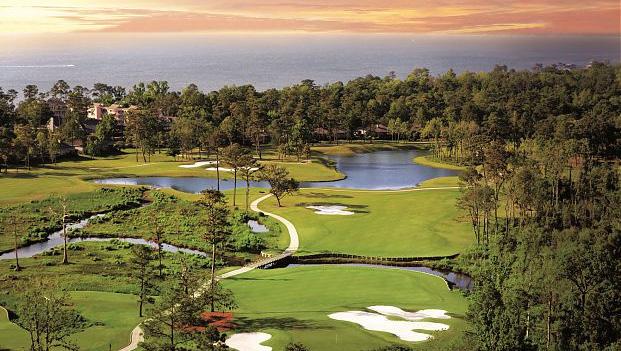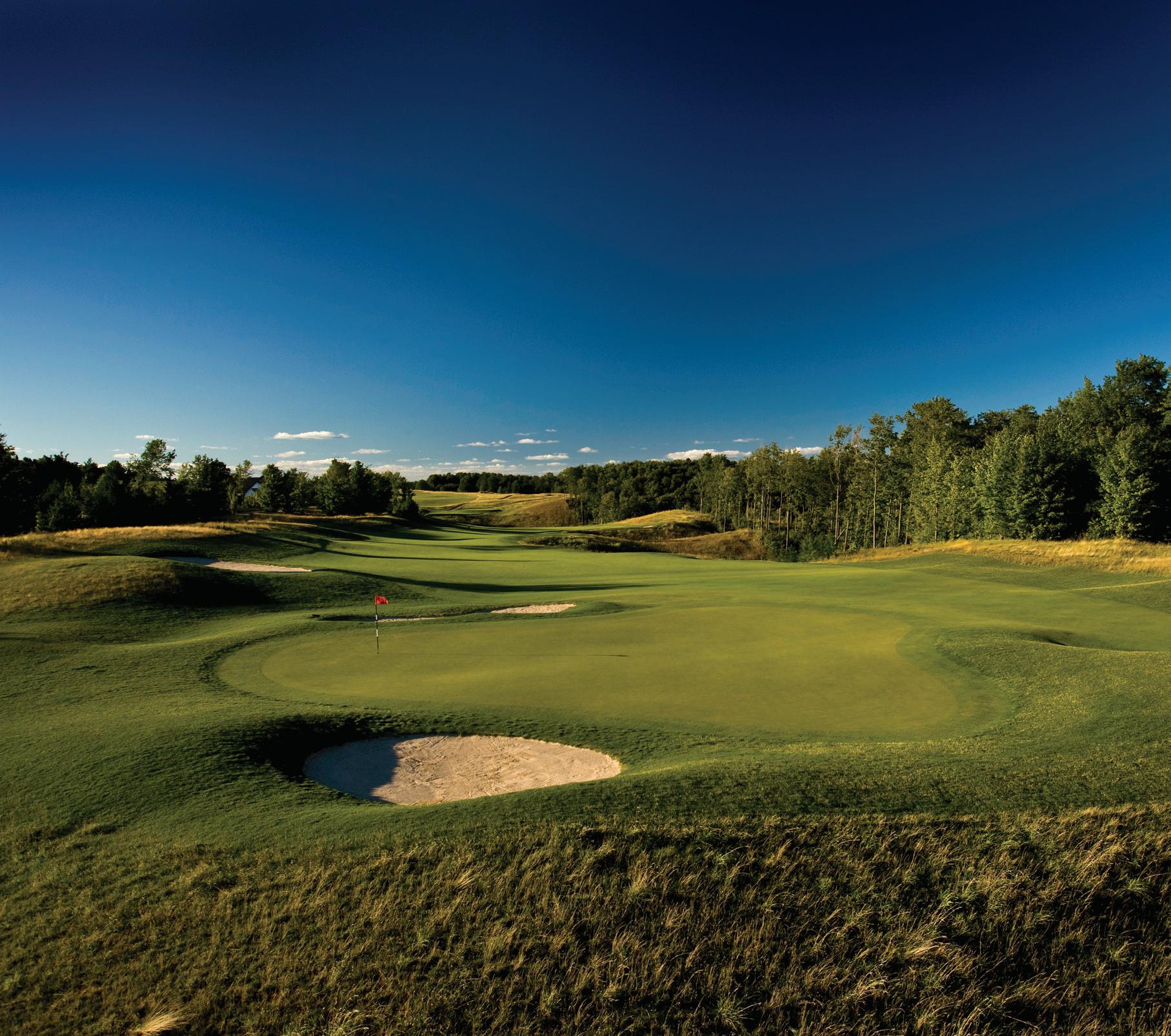
9 minute read
SOUTH
The beautiful layout of Dancing Rabbit GC in Philadelphia, Miss.
Dancing Rabbit GC is a perfect example of the Magnolia Golf Trail’s unique beauty
here are you when just to the west is Louisville, to the north is W Lexington, to the south is Decatur and due east is Philadelphia?
You are, naturally, in the middle of Mississippi and, not so long ago, the middle of nowhere. But today you can tee it up right there at what many regard as the best golf destination in the state — Dancing Rabbit Golf Club, situated in a rural area on the once-impoverished Choctaw Nation reservation, but transformed in recent years by the successful development of the Choctaw Nation’s casino hotels — the Silver Star and Golden Moon, which draw thousands annually from all over the country, especially the Southeast, for gaming and golf.
There are two elite 18-hole courses at Dancing Rabbit — The Azaleas and The Oaks, which serve as nationally acclaimed amenities of the hotels. “These are the flagship courses in the state,” says Mark Powell who oversees the 750acre property that runs through primitive pines and hardwoods and traverses dozens of small lakes and native streams.
Little more than 25 years ago, this remote area was far removed from a tourist/golf haven. Poverty, unemployment and despair gripped the tribe until Phillip Martin, elected the tribal chief in 1979, and brought changes for his people. Chief Martin lured various manufacturers to the area along with the casinos and subsequent supportive facilities, part of what is now the Pearl River Resort. More than 7,000 people found employment and wages soared beyond $200 million annually.
BY BOB SHERWIN
“When the casinos were built, there were literally lines to play a machine, lines to get into the building,” says Powell. “But the Chief had the foresight to realize the area still needed an identity to attract more people. He wanted to build a great golf course and wanted the best designer in the country to build it.”
Tom Fazio, architect of more than 200 courses, many among the most decorated in the land, and Jerry Pate, a native son of the South and the 1975 U.S. Open champion, were hired for the job. The Azaleas course was completed in July 1997 and the Oaks in June 1999. Like the casinos, the courses enjoyed immediate success and drew praise from golf periodicals, proclaiming them the best in the state and among the 100 best public courses in the country.
“Tom Fazio created 36 beautiful golf holes, but the two courses could not be more different,” says Powell. “The Azaleas has been compared to Augusta (National). It’s not Augusta but it has a feel of it with the hills, the natural creeks, and flowers. The Oaks is more open with rock formations, rock walls, and water hazards. And you have a downhill shot for virtually the entire course.”
Perhaps the most intriguing hole on Azaleas is the closer, a 500-yard par-4. You need a solid tee shot up a hill to have a chance at the green in two. Then you hit a downhill approach to a narrow green opening, with a pond right front, bunkers left and a green hill around it. “The 18th green is 50 steps deep,” says Powell. “We change the hole position every day, so it might be a 7-iron to the front one day and a fairway-metal to the back the next.”
No. 13, a 206-yard par-3, is perhaps the Azaleas’s most scenic hole. A long, straight shot is required as you shoot through a narrow gap in the trees toward a green guarded by a left-side creek that turns across the front. There are also two bunkers right willing to accept any shot with the slightest wrinkle.
The most talked about hole on the property, though, might be Oaks No. 12. The No. 1 handicap hole is a 444-yard, par-4 with a slight dogleg left off the tee then a slight dogleg right approach to a green protected by three large bunkers on the right and a formidable slope.
The two casinos have more than 1,000 combined rooms, but the best place to stay is one of the eight suites above the clubhouse. “A lot of people say it’s one of the best stays in golf,” says Powell. “In the morning you just walk down the stairs to the pro shop.”
Dancing Rabbit has a ‘golf marketing partnership’ with various Mississippi courses but is not officially part of the State’s acclaimed Magnolia Golf Trail. There is one other Tom Fazio-designed course in the state — Fallen Oak in DeSoto National Forest, near Saucier. Not surprisingly, it features ribbons of green cutting through tall forests with dramatic elevation changes. There are five par-5s, including the 600-yard 15th hole, and the course is an amenity of the Beau Rivage Resort in Biloxi.
Fallen Oak is about a three-hour drive from Dancing Rabbit to complete a mini-Fazio Trail. It’s a route that takes you past Buzzards Roost, Buckatunna and Whynot, through the wistful nowhere of southern Mississippi.
The RTJ Golf Trail’s tide of stay and play offerings keeps rolling
Lakewood Club • Point Clear, Ala.
BY TONY DEAR

Chip Purser has been at the Robert Trent Jones Trail’s Ross Bridge Golf Course, in the Birmingham, Ala. suburb of Hoover, since day one…actually four months before day one as the Director of Golf obviously needed to prepare for opening day.
After 16 years at this 2005 addition to the Trail, designed by Jones’s longtime associate Roger Rulewich (Jones had passed in 2000), no one knows more about the place than Purser who enjoys nothing better than talking about it.
That’s not true. He’d much rather be playing the course than talking about it. Ross Bridge, a former venue of the Champions Tour’s Regions Charity Classic (2006-09), is one of the longest courses in the world, stretching to 8,191 yards from the back tees. But not only is it very long, it’s also very beautiful. “There’s a great view from so many holes,” says Purser. “But I especially enjoy the closing two. The 17th is really something – a long par-4 with water down the right side. The view of the two waterfalls, the 9th green, and the hotel in the background is just amazing. Same at the 18th – another tough par-4.”
Purser say guests mention these two holes in particular when talking about the course, but that’s not all. “Visitors are just in awe of the scale of it,” he says. “It’s laid out over something like 300 acres so there’s plenty of separation. People say they just feel like they are out on their own, enjoying their game.”
Everyone that chooses the right set of tees (there are five options) will likely enjoy their game at Ross Bridge, the only one of the Trail’s 11 sites that has just the one course. The other ten facilities boast another 450 holes between them, made up of full 18s, short 18s, regulation nines, and short nines.
Though it doesn’t sound much fun, perhaps my favorite regulation nine on the Trail is the Backbreaker at Silver Lakes, 75 miles northeast of Birmingham. The course lost an estimated 50,000 trees during a violent tornado in 2011 but, after what must have been a backbreaking clear-up effort, the course came back with an altogether different look. It’s hardly a barren links-style course nowadays, but the Backbreaker is open in places it wasn’t before, and is an awesome mix of tree-lined and exposed holes with incredibly firm and fast greens.
Director of Golf Jason Callan nominates the 9th as his favourite hole. “It’s a beautiful, downhill par-5 with Lee’s Lake on the left and the Appalachian foothills as a backdrop,” he says. “It’s certainly reachable in two, but there’s a lot of water out there so be careful.” The nine-hole Short Course at Silver Lakes is one of the Trail’s most memorable and you really shouldn’t miss it.
You really shouldn’t miss anything on the Trail to be honest, but if you’re flying in and out of Atlanta or Birmingham it would behoove you to add the magnificent Grand National and/or Oxmoor Valley to your itinerary.
There are two regulation 18s at Grand National and a fantastic short 18. Scott Gomberg says a lot of people’s most memorable hole is the 15th on the former Barbasol Championship host Lake Course, a 230-yard par-3 that does a clockwise half-turn around 600-acre Sougahtatchee Lake. “It can play as little as 100 yards though,” says the Director of Golf. “There’s a tee for everyone.”
Eric Pigman, Head Professional at Oxmoor Valley, just a three-minute drive from Ross Bridge, has a harder time picking out one hole from the two regulation 18s and short 18 on offer, but plumps for the par-5 3rd on the Ridge, a real rollercoaster of a course with much elevation change and which must have been one of the harder courses to construct at any of the eight original sites that opened in 1992. Pigman’s choice of the 3rd hole features a wide but fairly shallow green wedged between a shale rock backboard and a rocky rise fronting the putting surface. It’s a cool way to end an incredible hole.
Along with all the great-value golf, there are eight fabulous upscale hotel/ resorts dotted along the trail, making it easy to put package tours together. Just visit rtjgolf.com to build your own package or choose one of the special package offers available throughout the year. Submit your contact information and one of the Trail’s reservations team members will get back to you to make all the arrangements.
What could be simpler? Definitely not Ross Bridge from the tips.
With good reason, the RTJ Trail gets the lion’s share of golf media attention in Alabama. But you’re mistaken if you think it’s the only public golf worth visiting in the Yellowhammer State.
On the coastline, 35 miles west of Pensacola, Fla. is the resort city of Gulf Shores, Alabama’s southernmost settlement whose sugar-white beaches, subtropical climate (annual temperatures range from about 60 to 90 degrees), and exceptional fishing/seafood make it a popular year-round destination but especially in the spring and fall. Add golf to beach-time and fishing for an outstanding trip. Coastalalabamagolf.com lists nine courses in the area, a few pearls among them.
Jerry Pate’s Kiva Dunes often ranks as the state’s most popular publicaccess course. A little low-country marshland combines with lush wetlands and even some genuine links for an incredible experience that 99% of golfpass.com users recommend.
Another favorite is 54-year-old Gulf Shores Golf Club originally designed by Earl Stone — something of a design legend in the Deep South. GSGC was actually the first course in town and was later (2005/6) renovated by Jay and Carter Morrish who added 300 yards, bringing the course’s total to over 6,800.
Other standouts include Arnold Palmer’s 36 holes at Craft Farms, Bruce Devlin/Robert Van Hagge’s GlenLakes, and three more Earl Stone beauties — Peninsula Golf and Racquet Club, Rock Creek and Timbercreek.
Gulf Shores has promoted itself as a couples destination in recent years, recommending some amazing condo apartment units, such as the ultra-modern and luxurious Turquoise Place, as being ideally configured for couples’ requirements. But there’s plenty of options for families, buddy groups, singles…anyone looking to discover a destination they may not be familiar with now but one to which they’ll surely want to return. Visit coastalalabamagolf. com to build a stay-and-play package you’ll long remember.










